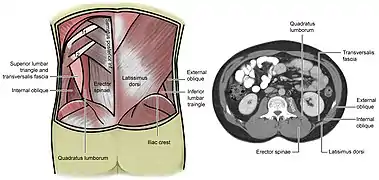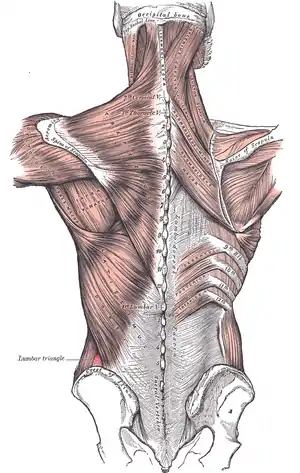Lumbar triangle
The lumbar triangle can refer to either the inferior lumbar (Petit) triangle, which lies superficially, or the superior lumbar (Grynfeltt) triangle,[1] which is deep and superior to the inferior triangle. Of the two, the superior triangle is the more consistently found in cadavers[2] and is more commonly the site of herniation; however, the inferior lumbar triangle is often simply called the lumbar triangle, perhaps owing to its more superficial location and ease in demonstration.
| Lumbar triangle | |
|---|---|
 The superior and inferior lumbar triangles with a cross section at the level of the superior lumbar triangle | |
 Posterior view of muscles connecting the upper extremity to the vertebral column. Lumbar triangle is labeled in red at bottom left. | |
| Details | |
| Identifiers | |
| Latin | trigonum lumbale |
| TA98 | A01.2.05.009 |
| TA2 | 270 |
| FMA | 75023 |
| Anatomical terminology | |
Inferior lumbar (Petit) triangle
The margins of the inferior lumbar (Petit's) triangle are composed of the iliac crest inferiorly and the margins of two muscles – latissimus dorsi (posteriorly) and external abdominal oblique (anteriorly). The floor of the inferior lumbar triangle is the internal abdominal oblique muscle. The fact that herniations occasionally occur here is of clinical importance.[3] A lumbar hernia here is called a Petit's hernia.
Superior lumbar (Grynfeltt-Lesshaft) triangle
The superior lumbar (Grynfeltt-Lesshaft) triangle is formed medially by the quadratus lumborum, laterally by the posterior border of internal abdominal oblique muscle, and superiorly by the 12th rib. The floor of the superior lumbar triangle is the transversalis fascia and its roof is the external abdominal oblique muscle. A Grynfeltt-Lesshaft hernia can occur here.
References
- Guillem P, Czarnecki E, Duval G, Bounoua F, Fontaine C (February 2002). "Lumbar hernia: anatomical route assessed by computed tomography". Surg Radiol Anat. 24 (1): 53–6. doi:10.1007/s00276-002-0003-z. PMID 12197011. S2CID 36988433.
- Goodman, E. H. and Speese, J.: Lumbar Hernia. Ann. Surg., 63:548, 1916.
- "Healthgrades Health Library".
External links
- Anatomy photo:01:02-0104 at the SUNY Downstate Medical Center